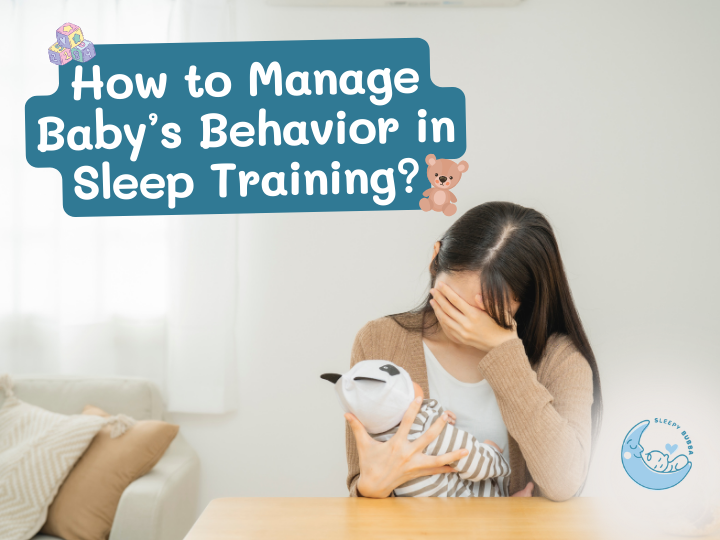Enquire Now with FREE 15 Mins Call
How to Manage Baby’s Behavior in Sleep Training?

Babies are creatures of habit, and any changes, especially to their sleep routines, can be met with resistance. Nowadays, parents would engage with a certified baby sleep consultant to overcome their baby’s sleep challenges through sleep training. Sleep training is a common approach to help babies learn to sleep through the night, and it often involves changes to their bedtime behaviors. But how do you manage behavior during sleep training?
When embarking on the journey of sleep training your baby, you may encounter various sleep training methods, each with its approach to handling your baby’s behavior. Three of the main sleep training approaches are:
1. Pick-Up-Put-Down Method
Put the baby in bed awake at the end of the bedtime routine. If the baby cries, wait a few minutes before you pick up, soothe, and put down the baby. Repeat the process until the baby falls asleep.
2. Stay In The Room Method
This method involves you sitting on a chair next to your baby’s crib until the baby falls asleep, without picking the baby up in the whole process. You move the chair further away each night until you’re completely out of the room.
3. Leave and Check Method
This involves letting your baby cry for a set period before you check on the baby. The goal is to gradually increase the length of the timed intervals of crying until the baby learns to self-soothe.
Regardless of the method you choose, you can expect some resistance from your baby. Babies are creatures of habit, and any change to their bedtime routine can be met with protest. Up until now, your baby may have relied on your comforting actions, such as rocking, feeding, or patting, to fall asleep. Now, they are transitioning into a phase where these nighttime crutches are gradually replaced with self-soothing techniques. This change can be met with resistance as your baby adapts to a new way of falling asleep.
Here are some key points for parents to consider while managing their baby’s behavior during sleep training:
1. Co-sleeping and Feeding Transitions
If your baby has been accustomed to co-sleeping or nighttime feeding, they may become clingy as these familiar closeness factors change. This adjustment can lead to fussiness during the daytime as your baby seeks that closeness during waking hours. It’s important to note that co-sleeping is associated with infant sleep issues, including frequent nighttime awakenings and difficulty falling asleep independently. While your baby may initially resist these changes, remember that consistency is key to their successful transition.
2. Overcoming Sleep Debt
Just like adults, babies can accumulate sleep debt if they don’t get enough restorative sleep. Sleep debt can lead to increased fussiness and resistance to sleep training methods. To address this, ensure your baby follows a consistent sleep schedule with the same bedtime and wake-up time each day. This can help regulate your baby’s sleep patterns and reduce negative behaviors.
3. Starting at the Right Time
It’s crucial to choose an appropriate time to begin sleep training. Around 4-6 months of age, most infants have developed the ability to self-soothe. Starting sleep training at this stage, rather than earlier, can yield better results. Avoid starting sleep training during significant developmental milestones, as these can disrupt sleep patterns.
4. Assurance in a Loving Environment
It’s essential to understand that whichever sleep training method you choose, as long as your baby is in a responsive and loving family environment, it won’t harm them. Babies are intelligent and adaptable. They will soon realize that you are there to comfort them and meet their needs during the day, but nighttime crying will no longer result in the same level of positive response as before. Gradually, they will learn this new skill and discover that falling asleep independently is not as daunting as it may seem.
5. Allowing Room for Adjustment
A newborn’s body clock typically takes 4-6 weeks to adjust. After birth, your baby needs to develop their circadian rhythm and adapt to a 24-hour cycle. While this adjustment is ongoing, be patient with your baby. Some infants establish a consistent rhythm within a few weeks, while others may require more time, often reaching a stable circadian rhythm at 3-4 months old.

Conclusion
In summary, sleep training is a valuable process for helping your baby develop healthy sleep habits, but it can initially lead to some resistance and behavioral changes. Persistence and consistency are key to a successful sleep training journey. While it may seem challenging at times, rest assured that your baby will adapt and learn to self-soothe over time. If you find yourself struggling with sleep training for an extended period, consider consulting a certified baby sleep consultant for guidance and support on your parenting journey. A baby sleep specialist can provide the guidance and support you need to develop a baby sleep training plan that works for your family. At Sleepy Bubba, we are committed to helping families get the rest they need. If you’re ready to get started on your sleep training journey, schedule a FREE 20-minute discovery call with us today, and let us help you and your baby achieve restful nights.







